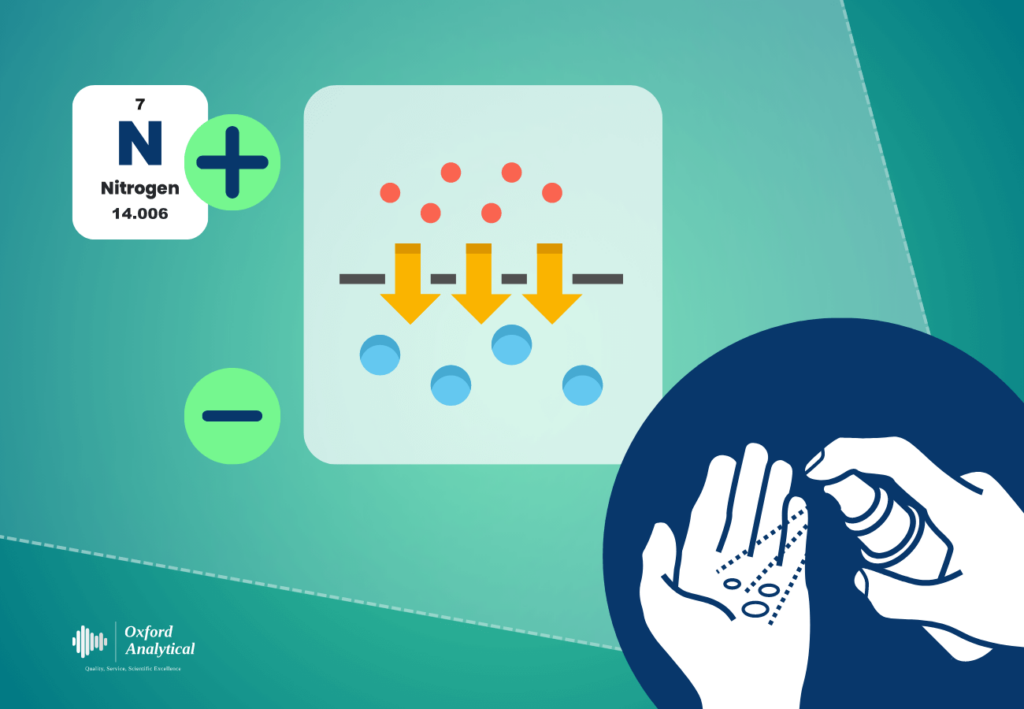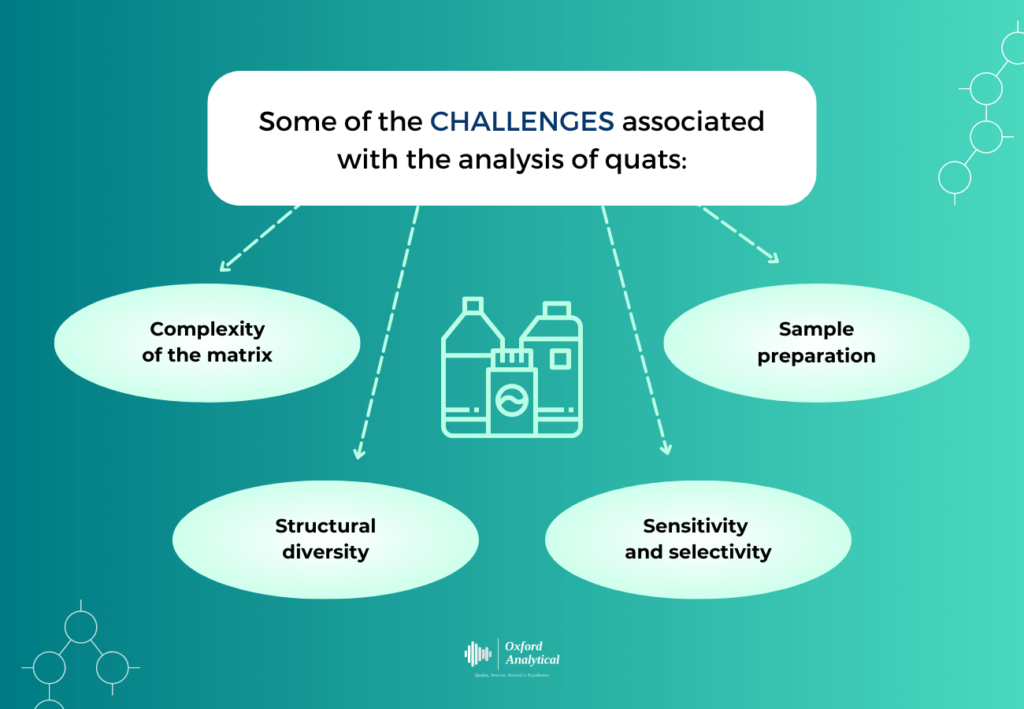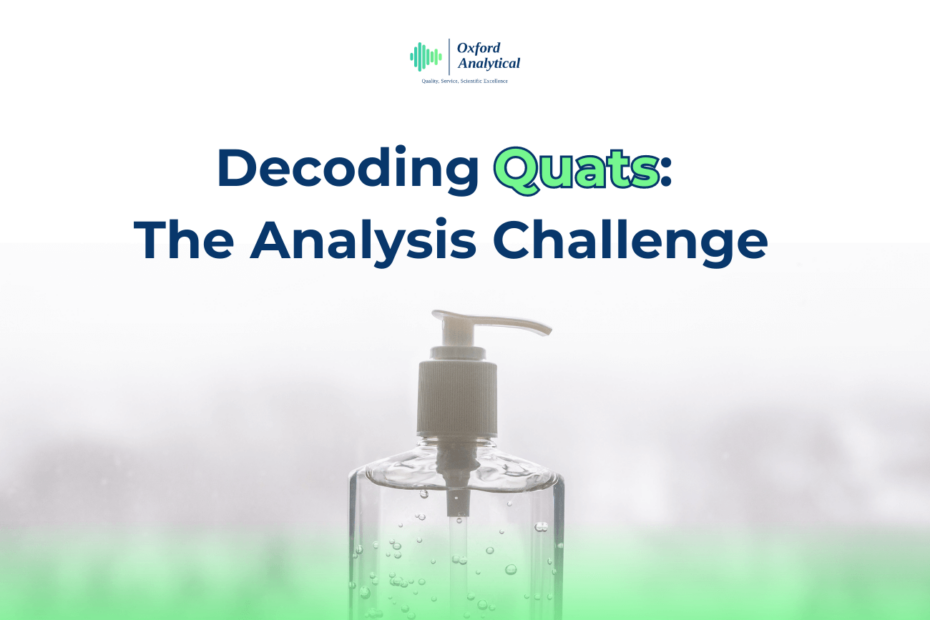In modern hygiene practices, quaternary ammonium compounds, commonly known as “quats,” are considered vital disinfectants and sanitisers. With their unique chemical structure and properties, quats offer a versatile and effective solution for combating microbial threats in various industrial and household applications. At Oxford Analytical Services, we understand the importance of quats and the difficulties involved in their analysis. In this blog post, we will explore the diverse applications of quats and explain the intricate process of analysing them.
How Versatile Are Quaternary Ammonium Compounds?
Quats are a class of cationic surfactants that exhibit exceptional antimicrobial properties. This remarkable attribute arises from their molecular structure, which includes a positively charged nitrogen atom. This positive charge enables quats to interact with negatively charged surfaces, such as cell membranes. When quats come into contact with microbial cell membranes, this leads to disruption of the membrane and cell death.

Let’s explore some noteworthy examples of quats and their applications:
Benzalkonium chloride (BAC)
BAC is a ubiquitous quat found in various products, ranging from disinfectants and sanitisers to fabric softeners and eye drops. Its versatility and broad-spectrum antimicrobial activity have earned it a prominent place in everyday life.
Cetylpyridinium chloride (CPC)
CPC is a key ingredient in oral hygiene products such as mouthwashes, throat sprays, and lozenges. Its antiseptic properties make it invaluable for maintaining oral health and combating bad breath.
Dodecylbenzenesulfonic acid (DDBSA)
DDBSA may not be as well-known as other quats, but it plays a pivotal role as a surfactant in certain detergents and cleaning products. Its ability to reduce surface tension enhances the efficacy of cleaning formulations.
Dodecyltrimethylammonium chloride (DTAC)
DTAC finds its niche in personal care products such as fabric softeners, hair conditioners and cosmetics. Its positive charge contributes to conditioning effects and improved product performance.
Alkyl dimethyl benzyl ammonium chloride (ADBAC)
ADBAC is a cornerstone of household cleaning products, disinfectants and sanitisers. Its broad effectiveness against various pathogens makes it an essential tool for maintaining cleanliness and hygiene.
Alkyl dimethyl ethylbenzyl ammonium chloride (ADEBAC)
ADEBAC’s role in wipes, sprays, and surface sanitisers demonstrates its versatility in diverse applications. Its presence ensures that surfaces remain germ-free and safe.
Didecyl Ammonium Chloride (DDAC)
Commonly used in various applications, DDAC functions as a disinfectant, sanitiser, or preservative, derived from the reaction of didecylamine with Hydrochloric Acid to produce chloride salt.
Polyhexamethylene Biguanide (PHMB)
PHMB is a type of quat also commonly used as a disinfectant, sanitiser, preservative or antimicrobial agent. It is also known as polyhexanide or polyaminopropyl biguanide. It is part of the wider group of ”biguanide” quats. Its chemical structure consists of a linear chain of hexamethylene groups with biguanide functional groups (-C(NH)-NH-) which lends it robust antimicrobial properties.
Navigating Complexities: Analysing Quats with Precision
The analysis of quats is not without its challenges. Oxford Analytical Services is leading the way in providing accurate insights. Here are some of the hurdles we tackle:

- Matrix Complexity: Quats are often found within complex matrices like food, soil or wastewater. These matrices contain a myriad of organic and inorganic compounds that can interfere with quat analysis, making it difficult to obtain accurate and precise measurements.
- Structural Diversity: Quats can have different structures and functional groups, which can affect their behaviour and properties. This structural diversity can make it challenging to develop standardised methods for the analysis of quats.
- Sensitivity and Selectivity: Quats are typically present at low concentrations in the matrices of interest, which can make their detection and quantification challenging. Additionally, quats may have similar structures to other compounds present in the matrix, which can affect their selectivity and lead to false positives or negatives.
- Sample Preparation: The preparation of samples for quat analysis can be time-consuming and complex. It often involves extraction and purification steps to remove interfering compounds and concentrate the quats.
Mastering the Analytical Landscape: Techniques and Expertise
To overcome the challenges of quat analysis, at Oxford Analytical Services we have honed an array of analytical techniques. Our methodologies seamlessly integrate sample preparation, chromatographic separation and mass spectrometric detection.
Liquid Chromatography Coupled with Tandem Mass Spectrometry (LC-MS/MS) is a commonly used technique for the analysis of quats in complex matrices. This method excels in separating quats from matrix compounds, allowing for precise quantification even at low concentrations. Its selectivity ensures reliable results by minimising the risk of false positives or negatives.
Oxford Analytical Services Expertise: Pioneering Quat Analysis
Our proficiency extends across multiple analytical avenues, encompassing HPLC, LC-MS/MS and wet chemistry techniques like titrations. We’ve developed in-house methodologies tailored to different quat types. These methods help us learn a lot about quats and how they work. Using different tools is like looking at quats from different angles to see the whole picture.
____________________
Conclusion
In the dynamic landscape of modern hygiene and sanitation, quats stand as versatile and indispensable players. Oxford Analytical Services leads the charge in understanding these compounds, overcoming challenges and delivering accurate insights.
To learn more about how we can assist you with your analytical needs, contact us today. Your partnership with us contributes to unlocking the transformative power of quats in our shared pursuit of a better tomorrow.

